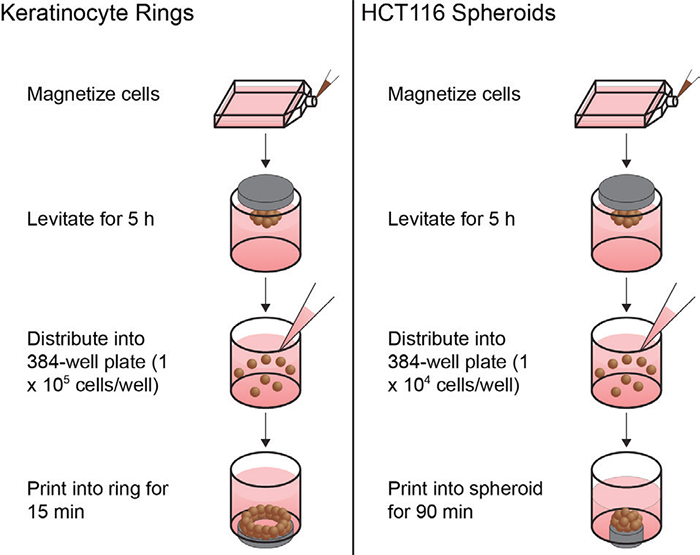
Magnetic 3D bioprinting: Principle, Applications, and Advantages
Three-dimensional (3D) cell culture models have gained more popularity over the last decade due to the advantages of better mimicking the in vivo microenvironment and tissue microarchitecture. However, applications of 3D cell culture models in high-throughput biomedical research are limited due to handling, processing, and scalability challenges. To meet these challenges, there has been a growing push toward magnetic 3D bioprinting platforms (1).
Principle of magnetic 3D bioprinting:
Magnetic 3D bioprinting involves assembling the layers of cells or magnetic nanoparticles onto a substrate using a magnetic field. The magnetic field guides the spatial arrangement of cells or nanoparticles into a specific pattern to create a biologically relevant 3D structure. Once assembled, these cells can form spheroids or organoids with features of tissue microenvironment, including ECM and cell-cell and cell-ECM interactions (1,2).
Applications of magnetic 3D bioprinting
1. Regenerative medicine: By using cells isolated from patients, the resulting tissue constructs can be used for implantation without the risk of rejection. This way, 3D magnetic bioprinting has the potential to create customized implants for regenerative medicine (3,4).
2. Tissue engineering: Magnetic 3D bioprinting can create complex tissue constructs mimicking the structure and function of native tissues, which can be used for in vitro drug testing and disease modeling (3).
3. Drug screening: Precise control of cell positioning offers accurate and relevant conditions for drug testing, since the cells are arranged to mimic the native tissue environment (5,6).
Advantages of 3D magnetic bioprinting over traditional bioprinting:
1. Precise and accurate: Magnetic field allows for precise control over cell positioning and orientation during the printing process, enabling the creation of complex, functional tissue-like structures.
2. Versatile: Magnetic 3D bioprinting can be used for a variety of cell types, including stem cells, primary cells, and cell lines.
3. Customizable: It enables the design and print of 3D structures with specific shapes and sizes for the creation of customized tissue-like constructs matching the individual needs of patients.
4. Reduced cell damage: Magnetic 3D bioprinting technique is biocompatible and non-toxic, minimizing cell damage during the printing process.
5. Scalable: The ability to create large-scale 3D structures allows to produce tissue-like constructs that can be used in clinical applications (7).
Overall, 3D magnetic bioprinting is a promising technology for tissue engineering, drug discovery, and regenerative medicine.
References
1. Li J, Chen M, Fan X, Zhou H. Recent advances in bioprinting techniques: approaches, applications and future prospects. J Transl Med. 2016 Sep 20;14:271. doi: 10.1186/s12967-016-1028-0. PMID: 27645770; PMCID: PMC5028995.
2. Souza GR, Molina JR, Raphael RM, Ozawa MG, Stark DJ, Levin CS, Bronk LF, Ananta JS, Mandelin J, Georgescu MM, Bankson JA, Gelovani JG, Killian TC, Arap W, Pasqualini R. Three-dimensional tissue culture based on magnetic cell levitation. Nat Nanotechnol. 2010 Apr;5(4):291-6. doi: 10.1038/nnano.2010.23. Epub 2010 Mar 14. PMID: 20228788; PMCID: PMC4487889.
3. Ozbolat IT. Bioprinting scale-up tissue and organ constructs for transplantation. Trends Biotechnol. 2015 Jul;33(7):395-400. doi: 10.1016/j.tibtech.2015.04.005. Epub 2015 May 12. PMID: 25978871.
4. Lee KV. Printing of three-dimensional tissue analogs for regenerative medicine. Ann Biomed Engin. (2017) 45:115–31. doi: 10.1007/s10439-016-1613-7
5. Friedrich, J., Seidel, C., Ebner, R. et al. Spheroid-based drug screen: considerations and practical approach. Nat Protoc 4, 309–324 (2009). https://doi.org/10.1038/nprot.2008.226
6. Satpathy A, Datta P, Wu Y, Ayan B, Bayram E, Ozbolat IT. Developments with 3D bioprinting for novel drug discovery. Expert Opin Drug Discov. 2018 Dec;13(12):1115-1129. doi: 10.1080/17460441.2018.1542427. Epub 2018 Nov 1. PMID: 30384781; PMCID: PMC6494715.
7. Kirillova A, Bushev S, Abubakirov A, Sukikh G. Bioethical and Legal Issues in 3D Bioprinting. Int J Bioprint. 2020 Apr 28;6(3):272. doi: 10.18063/ijb.v6i3.272. PMID: 33088986; PMCID: PMC7557521.



